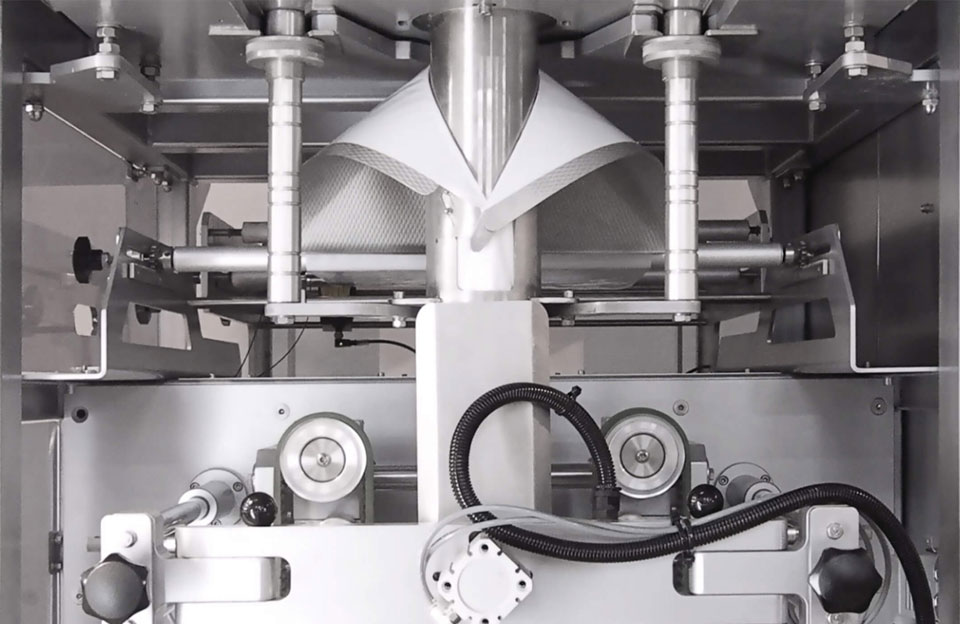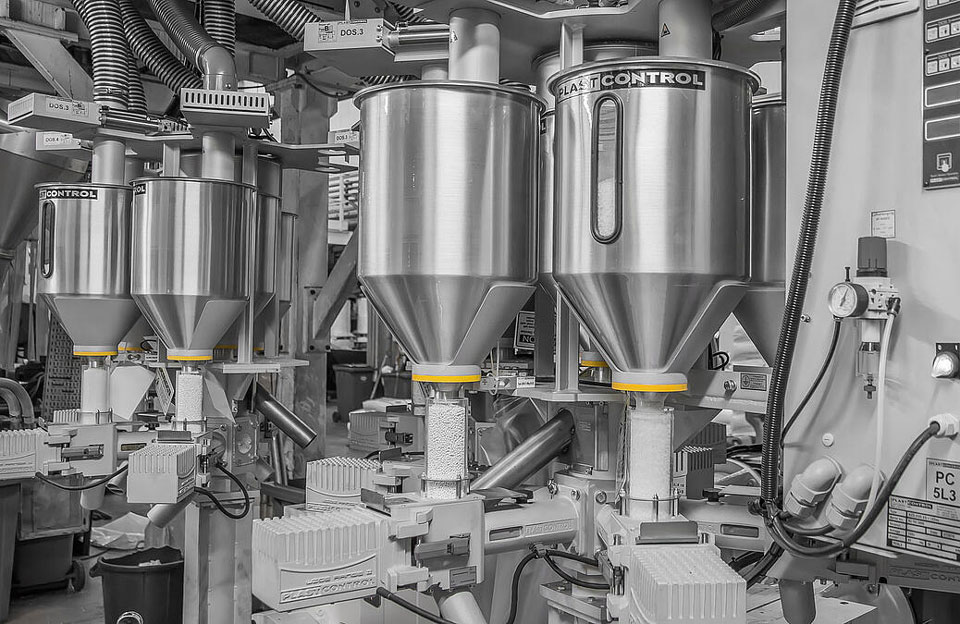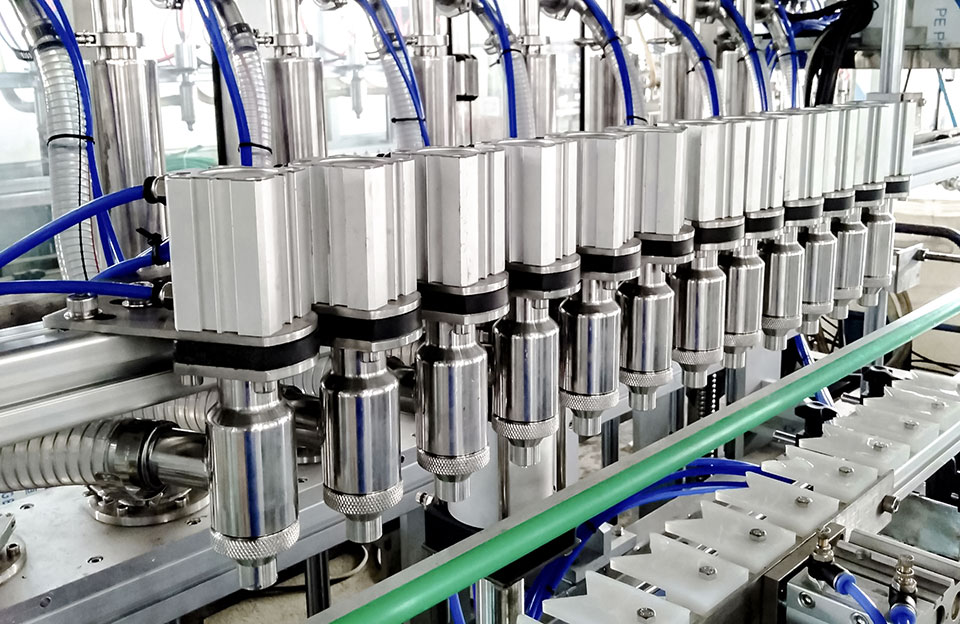The automatic filling of Prefabricated bags is usually divided into linear bag feeding machine and rotary bag feeding machine. During the filling process, its control system is based on PLC control system or similar automatic control system. Operators can set filling parameters such as material weight or volume, filling speed, sealing time, etc. through the control panel or touch screen interface to ensure the overall efficiency and accuracy of the filling process.
The Working Principle of Linear Automatic Bag Filling Machine
The working principle of the linear automatic bag-filling machine simplifies the bag-filling process and improves production efficiency and consistency. It is suitable for packaging various granular, powdery, and granular materials, such as food, chemicals, pesticides, fertilizers, etc.
- Bag Preparation: The operator places empty bags into the feed area, usually the bag conveyor system. Bags can be prefabricated or produced by the machines themselves.
- Bag Transportation: The conveying system in the feeding area moves the bags one by one to the filling area, usually by conveyor belt or other mechanical devices.
- Material Filling: The filling area has an appropriate material supply system, such as a hopper or a conveyor belt. The material is automatically or semi-automatically conveyed into the bag according to the predetermined measurement parameters.
- Weight or Volume Measurement: The automatic linear bag filling machine is always equipped with a weighing or volume measuring device to ensure that the material in the bag meets the predetermined weight or volume. These measuring devices can be load cells, flow meters, or similar devices.
- Bag Sealing: The bag enters the sealing area after filling. The sealing area is generally equipped with a heat sealing device or a compression device to seal the bag to ensure the safety and freshness of the material.
- Bag Out: After filling and sealing, the bag is moved out of the machine, usually through a conveyor belt or a mechanical arm, and transported to the next workstation or packaging area.
The Working Principle of Rotary Automatic Bag Filling Machine
Rotary automatic bag fillers are often used in high-speed filling applications because they can fill and seal bags continuously and are suitable for industries such as food, pharmaceutical, chemical, and agriculture that require precise and efficient bagging.
- Bagging: Place the empty bags on the rotary filling machine. Bags are usually held in place by bag clips or brackets.
- Bag Opening: The machine opens the bag ready to be filled, which can be achieved by mechanical means such as using a blower or vacuum system to inflate the bag and keep it open.
- Filling Material Supply: The machine feeds fill material such as granules, powder, or liquid into bags and can do so using a variety of mechanisms, including gravity feed, auger, or vibratory feeders.
- Fill Weight/Volume Measurement: During the filling process, the machine measures the weight or volume of the material dispensed into each bag, which can be done using load cells, flow meters, or other measuring devices integrated into the machine.
- Settling and Leveling: After filling, the machine ensures that the material settles and is level within the bag, with vibration or mechanical movement, to achieve consistent filling.
- Bag Sealing: It will move to the sealing station after the bag is full. The sealing station can use various methods such as heat sealing, ultrasonic sealing, or mechanical compression to seal the bag securely.
- Bag Out: After sealing, the filled and sealed bag is discharged from the machine and ready for further processing, labeling, or packaging.
Advantages of Fully Automatic Filling Machine
- Improve Efficiency: Automatic filling machines are designed for high-speed continuous operation, filling large containers or packages faster than manual or semi-automatic machines. Increased efficiency helps to increase overall productivity and throughput.
- Accurate and Consistent Filling: The automatic filling machine is equipped with precise measurement and control systems to ensure accurate and consistent filling of each container. They can maintain tight tolerances and minimize variations in fill volume, allowing for uniform product packaging and improved quality control.
- Reduce Labor Demand: With a fully automatic filling machine, the need for labor is significantly reduced. Once the machine is set up and programmed, it can operate independently with minimal human intervention. Using fully automatic filling machines reduces labor costs and frees personnel to focus on other critical tasks in the production process.
- Versatility and Flexibility: Fully automatic filling machines can handle a variety of container sizes, shapes, and materials. They often have adjustable settings that allow quick and easy switching between products or packaging requirements. This versatility and flexibility make them suitable for various industries and product lines.
- Integrated Control and Monitoring: Fully automatic filling machines usually have advanced control systems that allow operators to program and monitor various parameters, such as filling volume, speed, and machine diagnostics. This control and monitoring integration enables efficient operations, real-time adjustments, and troubleshooting.
- Improve Product Safety and Hygiene: The fully automatic filling machine is designed with hygiene and product safety in mind. Filling machines are designed with hygienic construction, easy-to-clean surfaces, and measures to prevent contamination. These are especially important in the food, pharmaceutical, and cosmetics industries, with high cleanliness and hygiene requirements.
- Enhanced Product Preservation: Fully automatic filling machines can incorporate additional features such as vacuum or gas flushing functions, which can help extend shelf life and maintain the quality of perishable or sensitive products. These features help create a controlled packaging environment and minimize product degradation.
- Integration with Packaging Line: Integration with packaging lines: Automatic filling machines can be seamlessly integrated into existing packaging lines for efficient and continuous production. To create a streamlined, automated production process, simultaneously synchronizing with other equipment, such as conveyor systems, lidding machines, labeling machines, or cartons, is possible.
Fully automatic filling machines increase efficiency, accuracy, versatility, and hygiene while reducing labor requirements. They are ideal for high-volume production environments, and industries where filling accuracy and consistency are critical.


